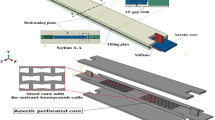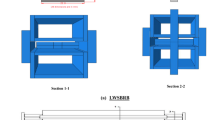Abstract
Buckling-restrained braces (BRBs) deliver ductile, stable, and repeatable hysteretic behavior. The plastic deformation capacity of the BRBs indicates the good indexes both in terms of ultimate deformation and in terms of energy dissipation capacity. In this paper, the load-carrying elements of BRBs were fabricated with steel (Chinese Q235), and four layers of plastic film (0.2 mm in thickness) were used as unbounded materials to prevent the buckling of inner cores in higher modes and provide spaces to facilitate its lateral expansion in case of compression. The differences of ultimate compression and tension loads were controlled in a small range. The transformation of the unrestrained segment’s section from crisscross shape to H shape can significantly improve the moment-resistance capacity of the unrestrained segment, avoiding buckling instability effectively due to evident moment stiffness enhancement. The experimental results of pseudo-static tests (PSTs) under cyclic load indicate: BRB with H cross section unrestrained segments can undergo fully-reversed axial yield cycles without loss of stiffness or strength, which have large ductility and superior seismic energy dissipation ability. There is obvious strain intensification in tension and compression phases. But there is evident decreasing of stiffness and strength on BRB with crisscross section unrestrained segments due to the buckling of unrestrained segment under compression, the ductility and energy dissipation ability decline distinctly.
Similar content being viewed by others
References
Black, C. J., Makris N. and Aiken I. D. (2004). “Component testing, seismic evaluation and characterization of buckling-restrained braces.” Journal of Structural Engineering, ASCE, 130(6), pp. 880–894.
Chen, C. C., Chen, S. Y., and Liaw, J. J. (2001). “Application of low yield strength steel on controlled plastification ductile concentrically braced frames.” Canadian Journal of Civil Engineering, 28(5), pp. 823–836.
Chou, C. C. and Chen, S. Y. (2010). “Subassemblage tests and finite element analyses of sandwiched bucklingrestrained braces.” Engineering Structures, 32(8), pp. 2108–2121.
Dusicka, P. and Tinker, J. (2013). “Global restraint in ultralightweight buckling-restrained braces.” Journal of Composites for Construction, 17(1), pp. 139–150.
Eryasar, M. E. and Topkaya, C. (2010). “An experimental study on steel-encased buckling-restrained brace hysteretic dampers.” Earthquake Engineering and Structural Dynamics, 39(5), pp. 561–581.
GB 50011-2010 (2010). Code for seismic design of buildings. China Architecture & Building Press, Beijing, China.
GB 50017-2003 (2006). Code for design of steel structures. China Architecture & Building Press, Beijing, China.
Genna, F. and Gelfi, P. (2012). “Analysis of the lateral thrust in bolted steel buckling-restrained braces. I: Experimental and numerical results.” Journal of Structural Engineering, ASCE, 138(10), pp. 1231–1243.
Gheidi, A., Mirtaheri, M., Zandi, A. P., and Alanjari, P. (2011). “Effect of filler material on local and global behaviour of buckling-restrained braces.” The Structural Design of Tall and Special Building, 32(8), pp. 700–710.
Hoveidae, N. and Rafezy, B. (2012). “Overall buckling behavior of all-steel buckling restrained braces.” Journal of Constructional Steel Research, 79, pp. 151–158.
Iwata, M. and Murai, M. (2006). “Buckling-restrained brace using steel mortar planks: performance evaluation as a hysteretic damper.” Earthquake Engineering and Structural Dynamics, 35(14), pp. 1807–1826.
Jia, M. M. and Lu, D. G., Sun L., and Zhang S. M. (2014). “Performance testing and cyclic behavior of buckling-restrained braces with H cross section unrestrained segments.” Advances in Structural Engineering, 17(5), pp. 677–692.
Ju, Y. K., Kim, M. H., Kim J., and Kim S. D. (2009). “Component tests of buckling-restrained braces with unconstrained length.” Engineering Structures, 31(2), pp. 507–516.
Koetaka, Y., Narihara, H., and Tsujita, O. (2001). “Experimental study on buckling restrained braces.” Proc. Sixth Pacific Structural Steel Conference, Beijing, China, pp. 15–17.
Lai, J. W. and Tsai, K. C. (2004). “Research and application of buckling restrained braces in Taiwan.” Proc. ANGER Annual Meeting, Hawaii, USA.
Merritt, S., Uang C. M., and Benzoni G. (2003). Subassemblage testing of corebace buckling restrained braces, Technical Report of Department of Structural Engineering. Report No. TR- 2003/01, University of California, San Diego, CA, USA.
Miller, D. J., Fahnestock, L. A., and Eatherton, M. R. (2011). “Self-centering buckling- restrained braces for advanced seismic performance.” Proc. Structures Congress, ASCE, Las Vegas, NV, USA, pp. 960–970.
Miller, D. J., Fahnestock, L. A., and Eatherton, M. R. (2012). “Development and experimental validation of a nickel-titanium shape memory alloy self-centering bucklingrestrained brace.” Engineering Structures, 40, pp. 288–298.
Palazzo, G., López, A. F., Cahís, X., and Crisafulli, F. (2009). “A low-tech dissipative buckling restrained brace. Design, analysis, production and testing.” Engineering Structures, 31(9), pp. 2152–2161.
Takeuchi, T., Hajjar, J. F., Matsui, R., Nishimoto, K., and Aiken, I. D. (2010). “Local buckling restraint condition for core plates in buckling restrained braces.” Journal of Constructional Steel Research, 66(2), pp. 139–149.
Takeuchi, T., Hajjar, J. F., Matsui, R., Nishimoto, K., and Aiken, I. D. (2012a). “Effect of local buckling core plate restraint in buckling restrained braces.” Engineering Structures, 44, pp. 304–311.
Takeuchi, T., Hajjar, J. F., Matsui, R., Nishimoto, K., and Aiken, I. D. (2012b). “Effect of local buckling core plate restraint in buckling restrained braces.” Engineering Structures, 44, pp. 304–311.
Tremblay, R., Degrange, G., and Blouin, J. (1999). “Seismic rehabilitation of a four-story building with a stiffened bracing system.” Proc. Eighth Canadian Conference on Earthquake Engineering, Vancouver, Canada, pp. 549–554.
Tsai, C. S., Chen, W. S., and Lin, Y. C. (2008). “Full scale shaking table tests of a steel structure with multi-curved buckling restrained braces.” Proc. Fourteenth World Conference on Earthquake Engineering, Beijing, China, Paper No. 05-06-0007.
Usami, T., Wang, C. L., and Funayama, J. (2012). “Developing high-performance aluminum alloy bucklingestrained braces based on series of low-cycle fatigue tests.” Earthquake Engineering Structural Dynamics, 41(4), pp. 643–661.
Wada, A., Connor, J., Kawai, H., Iwata, M., and Watanabe, A. (1992). “Damage tolerant structure.” Proc. Fifth U.S.-Japan Workshop on the Improvement of Structural Design and Construction Practices (ATC-15-4), Applied Technology Council, San Diego, CA, USA, pp. 27–39.
Wang, C. L., Usami, T., and Funayama, J. (2012). “Evaluating the influence of stoppers on the low-cycle fatigue properties of high-performance buckling-restrained braces.” Engineering Structures, 41, pp. 167–176.
Wang, C. L., Usami, T., Funayama, J., and Imase, F. (2013). “Low-cycle fatigue testing of extruded aluminium alloy buckling-restrained braces.” Engineering Structures, 46, pp. 294–301.
Watanabe, A., Hitomi, Y., Saeki, E., Wada, A., and Fujimoto, M. (1988). “Properties of braces encased in buckling-restrained concrete and steel tube.” Proc. Ninth World Conference on Earthquake Engineering, Tokyo-Kyoto, Japan, Volume IV, pp. 719–724.
Xie, Q. (2005). “State of the art of buckling-restrained braces in Asia.” Journal of Constructional Steel Research, 61(6), pp. 727–748.
Zhao, J. X., Wu, B., and Ou, J. P. (2012a). “Flexural demand on pin-connected buckling-restrained braces and design recommendations.” Journal of Structural Engineering, ASCE, 138(11), pp. 1398–1415.
Zhao, J. X., Wu, B., and Ou, J. P. (2012b). “Effect of brace end rotation on the global buckling behavior of pinconnected buckling-restrained braces with end collars.” Engineering Structures, 40, pp. 240–253.
Author information
Authors and Affiliations
Corresponding author
Additional information
Discussion open until May 1, 2015. This manuscript for this paper was submitted for review and possible publication on March 3, 2014; approved on December 1, 2014.
Rights and permissions
About this article
Cite this article
Jia, M., Guo, L. & Lu, D. Performance testing and comparison of buckling-restrained braces with H and crisscross cross section unrestrained segments. Int J Steel Struct 14, 745–753 (2014). https://doi.org/10.1007/s13296-014-1206-y
Published:
Issue Date:
DOI: https://doi.org/10.1007/s13296-014-1206-y




